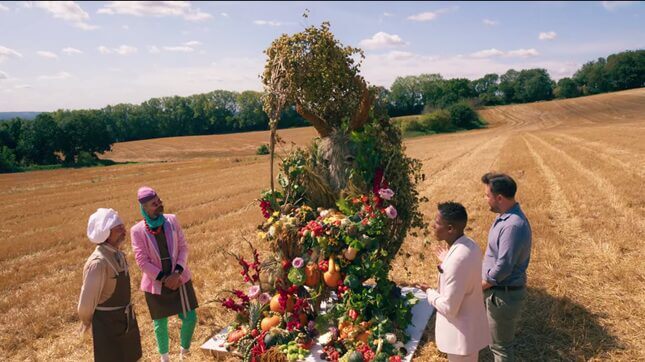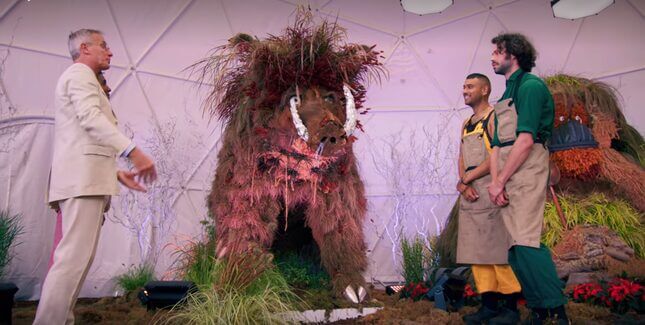

Every spring, the New York Botanical Garden unveils its showstopper exhibit for the summer season: the annual Orchid Show. The conservatory at the Botanical Garden is lovely enough on its own, but the Orchid Show injects a hearty dose of theatricality into an already-dramatic setting, which takes the edge off walking at a snail’s pace through greenhouses behind shuffling groups of tourists. Lush orchids dangle from every available surface, surrendering to the resident artist’s vision in full. Currently, the Botanical Garden is closed and the YouTube walk-throughs of this year’s show don’t quite scratch the itch like being surrounded by actual nature does —even if that nature is in a conservatory in the Bronx. Netflix’s latest feel-good reality offering, The Big Flower Fight, should have been a suitable replacement for that real-life experience that is sorely missed now, but unfortunately, it doesn’t quite live up to the task.
The Big Flower Fight is another entry in the wide-ranging field of process-oriented reality competition television, nicking its blueprint from its spiritual predecessor, The Great British Bake-off. Ten pairs of “amateur floral sculptors” find themselves in a geodesic dome in the middle of the English countryside, with access to a lavish nursery and metal workshop. They’re tasked with fulfilling a creative brief every episode, and naturally, a winner is crowned. Hosts Vic Reeves and Natalia Demetriou make jokes and shepherd the contestants through various landscaping and horticultural nightmares. The judge, Kirsten Griffith VanderYacht, auditioned for the role on video-chat after responding to an Instagram DM. His floral design company, Wild Bloom, is responsible for the flowers at Julianne Hough’s wedding, and the bridal bouquet (featured on the cover of People), is a gorgeous, free-form assemblage of ranunculi and trailing vines. In short, it’s beautiful and Griffith-VanderYacht, a perfect reality show judge.
Because The Big Flower Fight is part of the same kind of gentle competitive British reality TV, the cadence is instantly recognizable, and therefore comforting: the contestants all genuinely like each other and sail through each episode by the skin of their teeth. The fruits of their labor have a charming storybook quality; and the setting of the show induces deep pangs of envy for the outdoors, wide-open spaces, and the undulating hills of the British countryside. I hoped to feel the same sort of blissful stress relief that shows like The Great British Bakeoff provide, but part of the problem with The Big Flower Fight is the absence of stress. Without a frisson of panic, it loses its appeal.

On The Great British Bakeoff, a drip of yolk in a bowl of egg whites can ruin a meringue, and if the blast chiller doesn’t cool the cakes in time for the icing, disaster awaits. Wondering whether or not the contestants on The Big Flower Fight will pull off their creations in time isn’t nearly as satisfying, because unlike the GBBO contestants, they’re truly in charge of their own destiny. Baking is about control, and then ceding that control to an oven, but the floral and landscape designers on BFF are working against the clock, and then their own skills. While there’s no actual financial prize awarded to the winners of either show, winning GBBO can jumpstart a career. Nadiya Hussain, who won the sixth season, scored her own Netflix show, Nadiya’s Time to Eat. Ruby Tandoh, who was a runner-up on the fourth season of the show, has parlayed her time in the spotlight into a career as food writer. The winners of the BFF get an enormous rosette and the gentle satisfaction of being the best gardener in the UK, but I suppose it’s too early to tell if this accolade will net anything more.
It feels like a big bet on Netflix’s part to assume that an American audience has as big an appetite for a horticulture reality show as their British counterparts do. British reality TV teems with garden-focused programming, spearheaded by television personality Monty Don. His mini-empire of garden-focused reality shows are more edifying than The Big Flower Fight, and produce the pleasant soporific effect that I crave. In 2015, the BBC aired The Great Chelsea Garden Challenge, which is everything the Big Flower Fight should be: a high-stakes reality competition that encourages actual creativity by way of the prize, which is a spot in the annual Chelsea Garden Show. While the contestants of that show also design their gardens within the confines of a creative brief, the finished result is both practical and beautiful, with points docked for things like proper horticulture—making sure that the plants are grouped appropriately by light and water requirements—as well as aesthetics and ease of use.
The trouble with The Big Flower Fight is that the whole affair feels a bit lackluster, perhaps because the formula is no longer new. GBBO’s appeal was that it was a deliberate, marked change from the frenzy of American cooking reality TV. But maybe because Americans lack the context for any shows about gardening or horticulture in this very specific British context, the show doesn’t bloom like it should.The Big Flower Fight is currently streaming on Netflix.